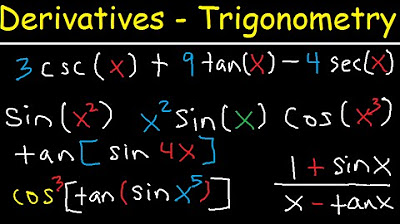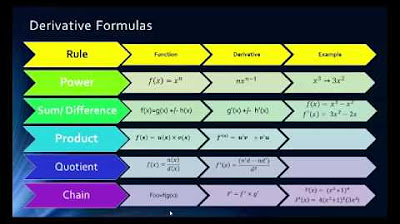Derivatives of Trig Functions - Calculus | MCV4U
TLDRThis educational video script offers a comprehensive guide on derivative rules for trigonometric functions. It begins by highlighting the importance of understanding the derivatives of sine, cosine, and tangent. The script then delves into applying various derivative rules, such as the power rule, constant multiple rule, sum and difference rules, chain rule, product rule, and quotient rule, to both basic and composite trigonometric functions. Examples illustrate the application of these rules, emphasizing the use of the chain rule for functions within functions and simplifying expressions using trigonometric identities. The transcript encourages viewers to practice these concepts and provides a resource for further learning.
Takeaways
- 📘 Learn to apply derivative rules to trigonometric functions, including power, constant multiple, sum, difference, product, quotient, and chain rules.
- 📌 Memorize the derivatives of the primary trigonometric functions: \( \frac{d}{dx}(\sin x) = \cos x \), \( \frac{d}{dx}(\cos x) = -\sin x \), and \( \frac{d}{dx}(\tan x) = \sec^2 x \).
- 🔑 Understand the importance of previous knowledge of derivative rules, especially the chain rule and product rule, for tackling more complex trigonometric derivatives.
- 🔍 Start with simple examples to practice finding derivatives of functions that are constants multiplied by trigonometric functions or differences of such functions.
- 📐 Use the chain rule when the argument of the trigonometric function is itself a function, differentiating the outer function with respect to the inner function.
- 📚 Differentiate composite functions by applying the chain rule, multiplying the derivative of the outer function by the derivative of the inner function.
- 📉 Recognize the notation for functions like \( \sin^2 x \) and \( \cos^2 x \) as \( \sin x \cdot \sin x \) and \( \cos x \cdot \cos x \) respectively, not as squared arguments.
- 🔢 Apply the power rule correctly when differentiating functions raised to a power, remembering to bring the exponent down and subtract one from it.
- ✂️ Simplify the results of derivatives where possible, and look for trigonometric identities that can further simplify the expressions.
- 📝 Practice is essential for mastering the derivative rules for trigonometric functions, so seek out additional problems and resources for practice.
- 📚 Visit Jensen Math for accompanying practice questions to reinforce learning and application of derivative rules for trigonometric functions.
Q & A
What are the main derivative rules covered in the video?
-The video covers the power rule, constant multiple rule, sum and difference rules, chain rule, product rule, quotient rule, and how to apply these rules to trigonometric functions.
What are the derivatives of the primary trigonometric functions with respect to x?
-The derivative of sine x with respect to x is cosine x, the derivative of cosine x is -sine x, and the derivative of tangent x is secant squared x.
What is the constant multiple rule in the context of derivatives?
-The constant multiple rule states that the derivative of a constant multiplied by a function is equal to the constant multiplied by the derivative of the function.
How does the sum and difference rule apply to derivatives?
-The sum and difference rule states that the derivative of a sum or difference of two functions is the derivative of each function subtracted or added from each other, respectively.
What is the chain rule and when is it used?
-The chain rule is used when differentiating a function that has another function as its argument. It involves differentiating the outer function with respect to the inner function and then multiplying by the derivative of the inner function.
Can you provide an example of using the chain rule with a trigonometric function?
-An example is differentiating sine of 4x. You differentiate sine with respect to 4x to get cosine of 4x, and then multiply by the derivative of 4x, which is 4.
What does the video mean by 'coast squared x' in the context of trigonometric functions?
-The term 'coast squared x' is a typographical error in the transcript; it should be 'cosine squared x', which means cosine x times cosine x.
How does the product rule apply to derivatives of trigonometric functions?
-The product rule is used when differentiating a product of two functions. It states that the derivative of the product is the derivative of the first function times the second plus the first function times the derivative of the second.
Can you give an example of using the product rule with a trigonometric function and a polynomial?
-An example is differentiating -x squared times sine of 3x minus pi. You use the product rule to differentiate -2x times sine of 3x minus pi plus 3 times -x squared times cosine of 3x minus pi.
What is the derivative of sine squared cosine with respect to x?
-The derivative involves using the chain rule and the derivative of sine squared x, which is 2 times sine x times the derivative of sine x, and then multiplying by the derivative of cosine x, which is -sine x.
How does the video explain the derivative of a function that includes a tangent function?
-The video explains that when differentiating a function that includes a tangent function, you use the power rule to bring down the exponent and then multiply by the derivative of the inside function, which in the case of tan x is secant squared x.
Outlines
📚 Introduction to Derivatives of Trigonometric Functions
This paragraph introduces the topic of the video, which is to teach viewers how to apply various derivative rules to trigonometric functions. It emphasizes the importance of knowing the derivatives of the three primary trigonometric functions: sine, cosine, and tangent. The paragraph also encourages viewers to review previous videos for a refresher on derivative rules such as the power rule, constant multiple rule, sum and difference rules, product rule, quotient rule, and chain rule. The video promises to combine these rules with the new trigonometric derivatives to tackle more complex functions.
🔍 Applying Derivative Rules to Trigonometric Functions
The second paragraph delves into the application of derivative rules to trigonometric functions. It starts with simple examples, such as differentiating a constant multiplied by a trigonometric function and a difference of two functions, using the constant multiple rule and the sum and difference rules, respectively. The paragraph then moves on to more complex scenarios, such as differentiating the sine of a function using the chain rule. It also covers the differentiation of trigonometric functions squared, like 'cos^2(x)', which requires understanding the notation and applying the chain rule and power rule correctly. The summary highlights the importance of simplifying the results and recognizing trigonometric identities where applicable.
📘 Advanced Trigonometric Derivatives and Chain Rule
The third paragraph focuses on more advanced examples of differentiating trigonometric functions, particularly when the argument of the trigonometric function is itself a function of x. It illustrates the use of the chain rule in these scenarios, showing how to differentiate 'sin(f(x))' and 'cos^2(x)'. The paragraph also discusses the product rule in conjunction with the chain rule for functions like 'y = -x^2 * sin(3x - π)'. It emphasizes the need to differentiate each part of the product and chain rule expressions correctly, and to simplify the results. The paragraph concludes with an example of differentiating a function involving 'tan(x)', which requires using the power rule and understanding the derivative of the tangent function.
Mindmap
Keywords
💡Derivative
💡Trigonometric Functions
💡Power Rule
💡Constant Multiple Rule
💡Sum and Difference Rules
💡Chain Rule
💡Product Rule
💡Quotient Rule
💡Sine Function
💡Cosine Function
💡Tangent Function
Highlights
Introduction to applying derivative rules to trigonometric functions.
Necessity of knowing the derivatives of sine, cosine, and tangent with respect to x.
Review of previous derivative rules like chain rule, product rule, and power rule.
Constant multiple rule applied to the derivative of 4 times sine x.
Differentiation of a difference function involving x squared and 3 cosine x.
Use of the chain rule for the derivative of sine of a function of x.
Differentiation of sine of 4x using the chain rule and the derivative of the inner function.
Clarification on the notation of trigonometric functions squared, not squaring the argument.
Differentiation of cosine squared x using the chain rule and power rule.
Simplification of the derivative using trigonometric identities, such as the double angle identity.
Application of product rule and chain rule to differentiate negative x squared times sine of 3x minus pi.
Differentiation of sine squared of cosine x, involving the chain rule and power rule.
Differentiation of a function involving tan x squared, using power rule and chain rule.
Final example of differentiating 10x plus cosine x squared, combining sum rule and power rule.
Emphasis on the importance of practicing these types of derivatives.
Invitation to visit Jenssen Math for accompanying practice questions.
Transcripts
Browse More Related Video

Derivatives of Trigonometric Functions - Product Rule Quotient & Chain Rule - Calculus Tutorial

AP Calculus AB: Lesson 3.1 Elementary Derivative Rules

DERIVATIVES that keep getting HARDER 🤯 | jensenmath.ca

Math 1325 Lecture 9 7 - Using Derivative Forumulas

The Chain Rule - Part 2

Calculus AB Lesson 3.4 The Chain Rule
5.0 / 5 (0 votes)
Thanks for rating: